Scene1: It is 7pm. Bhumila Kharai of Bormarjongbor in West Karbi Anglong district is inspecting one last time her produce: ginger, chillies, and turmeric meant for the Jonbeel Mela. She is planning an early dinner and sleep. The next morning she will be leaving for Jagiroad with some of her acquaintances to the Gobha Kingdom
Scene 2: Bandana Patar from Baropujia in Nagaon is all excited to unveil her collection of clothes in the Jonbeel Mela. Her stall, like others, will be a temporary one. She has dry fish, poha and dry sweets in a packet which she has carried from her village. The mela had been part of folklore for her, having heard about it many times from her father. It has become a reality today. Right in front of her temporary stall is a Tiwa woman. Bandana forwards her packet to the Tiwa woman and in turn gets a packet consisting of ginger, turmeric, and chillies. As she turns back, the Tiwa woman adds a couple of arum root for Bandana, free of cost.
These were two of the many such moments of this year’s mela near Jagiroad from January 19 to 21. It got underway with the traditional ceremony at the Charibhai Deohal Shivathan by the Gobha king. Besides other rituals, an important element on the first day was the interaction of the King with his subjects who are referred as mama (male) and mami(female)

This mela is a confluence of people, culture, and tradition of the people from the hills and the plains, and their produce which are exchanged and not traded. This custom has been in existence for scores of years. People from the highland descend to an open land near the beel for a few days by constructing a temporary shade.
The second day, beginning at 5am, one can see people bartering their goods and produce. These goods are made or cultivated by them. Those from the highland bring to barter produce like potato, turmeric, ginger, arum root. Besides these, potato, white gourd and water bottle gourd are the ones that are exchanged by the likes of this Tiwa woman for stuff like dry fish, sira, pitha, jaggery, milk-based dry sweet, etc. Tibisuri Pomai is one of those who participated in this exchange. “I came at 5am with turmeric, ginger, chiilies and arun roots, and exchanged them for dry sweets, dry fish, and peetha,” Pomai from Ulukunchi told this reporter.
Bhumila said, “I have been coming here for 10 years now. Earlier, I used to walk down to this place. This year, I took a transport ride. Each year, I meet new people. I enjoy this.”
‘‘The mela has helped us
to strengthen our cordial
ties with people from the
plain. What has helped in
the process is the
barter trade’’-Dipsingh Deoraja, Gobha King
The temporary market place has incentivised many small retailers who come with ethnic clothes, goods made of wood, and bamboo, utensils, ornaments, sports equipment, etc., besides traditional food items.
Kanika Kachari is one such retailer. “I have been coming here for the last 13 years. Sales are always encouraging. Besides, I like meeting those from the highland,” the trader from Goalpara told this newsletter.
This activity is followed by community fishing in the arom beel nearby. Folk songs, music, and dances are then followed by the traditional revenue collection from the subjects on the last day. In the afternoon, the Gobha King organises his court and issues royal allowance. A traditional attraction on the day is the cock fight.

The Gobha King Dipsingh Deoraja, who assumed the throne in 1995, told Asom Barta, ‘‘The mela has helped us to strengthen our cordial ties with people from the plain. What has helped in the process is the barter trade. I would appeal to the Government to solve our land disputes so that the tradition can continue for centuries to come.”
“We are trying to preserve tradition. This mela which is historical has also been able to draw international attention. We received a lot of support from the district administration this time as well,” said Jursingh Bordoloi, the secretary of Gobharoja Deuroja Jonbeel Mela Unnayan Samiti.
Premised on trust and tradition, built over centuries, the mela is not only a confluence of people, produce and ethnicity but also represents civilisational values.













